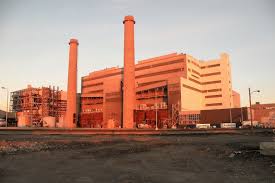DOE orders oil-and-gas Eddystone power plant to keep running three more months
Reprinted from Canary Media Aug. 28, 2025
By Dan McCarthy
The Department of Energy has once again delayed the retirement of the Eddystone oil and gas-powered electrical generating plant, adding to concerns that the Trump administration aims to prevent any fossil-fueled power plant from closing during its term. The owner, Constellation Energy Corp., had planned toclose it in May.
Today, the Trump administration reissued an emergency order forcing the Eddystone power plant outside of Philadelphia to stay open another 90 days. The plant’s two main units, totaling 760 megawatts, were originally set to shutter on May 31, but one day before their scheduled retirement, the DOE issued an emergency stay-open order, which expired today.
Eddystone is not the only fossil-fueled power plant being forced to stay open past its closing date. Last week, the Trump administration extended its emergency stay-open order for the J.H. Campbell coal plant in Michigan, which was also slated to close in May.
Before this year, the DOE had wielded its emergency powers sparingly, issuing orders mostly in response to utilities or grid operators who requested federal restrictions be lifted during times of extreme strain on the grid. It has never before used Section 202(c) of the Federal Power Act to intervene in a power plant retirement, according to Caroline Reiser, senior attorney for climate and energy at the Natural Resources Defense Council.
But under President Donald Trump, the agency is invoking those powers to extend the life of fossil-fueled units that grid planners had already deemed unnecessary, raising costs for consumers and stalling the transition to carbon-free energy.
In today’s order, the DOE once again pointed to an “emergency” in portions of the electricity grid operated by PJM Interconnection, which serves Washington, D.C., and 13 states from Illinois to Virginia. The agency cited recent reports from PJM that found, among other things, that the grid operator could struggle to keep up with demand this summer during heat waves.
The DOE said in the new order that the emergency conditions that led to the first directive are still in place, as summer isn’t over. The Eddystone station’s units 3 and 4 generated over 17,000 megawatt-hours during June, per U.S. Environmental Protection Agency data cited by DOE. They also ran for a combined total of 47 hours during a three-day spell of hot weather in late July.
The order also cites a widely criticized report that the DOE released in July, which energy experts say vastly overstates the risk of grid outages. The citation further confirms fears that the Trump administration will use the methodologically flawed report to continue to justify keeping aging, expensive fossil-fueled power plants online.
PJM has supported both stay-open orders, calling each one a “prudent, term-limited step” that would allow the DOE, PJM, and Eddystone’s owner, Constellation Energy, to analyze the longer-term need for these generators.
“PJM has previously documented its concerns over the growing risk of a supply and demand imbalance driven by the confluence of generator retirements and demand growth,” a spokesperson said in an emailed statement about the new order. “Such an imbalance could have serious ramifications for reliability and affordability for consumers.”
Regulators, energy experts, and advocates have questioned the DOE’s justification for keeping the Eddystone and the J.H. Campbell plants open. They point to the fact that the power plants’ owners, state officials, regional grid operators — including PJM itself — and other experts spent years evaluating the impact of closing these facilities and decided it was safe to shut them down.
For its part, the Eddystone plant has operated infrequently in recent years because the facility was not economical. Constellation filed a deactivation notice with PJM in December 2023, which was approved by the grid operator months later following a study that “did not identify any reliability violations” from the shutdown.
In June, state utility regulators and environmental groups filed rehearing requests with the DOE in an attempt to force the agency to reconsider its emergency orders. The agency denied those requests, clearing the way for critics, like the state of Michigan, to take the agency to court.
Advocates fear that these directives, taken together with recent executive orders and other DOE moves, signal the Trump administration’s commitment to keeping every fossil-fuel plant running, no matter the consequences.
In total, just over 38 gigawatts’ worth of power plants are slated to close between now and the end of 2028, more than two-thirds of which is coal.
Blocking all planned closures of fossil-fueled power plants would be disastrous for efforts to decarbonize the U.S. power grid — and also for consumers, who are already navigating fast-rising power bills. It could cost utility customers billions of dollars each year to prop up this unnecessary infrastructure, according to an August report from research firm Grid Strategies.
The administration’s statements have done little to quell advocates’ fears. In fact, a Tuesday post on X from the DOE was crystal clear.
“Coal plants will STAY IN OPERATION,” it read.
Susbscribe to Canary mdia nesletters: More about our newsletters

